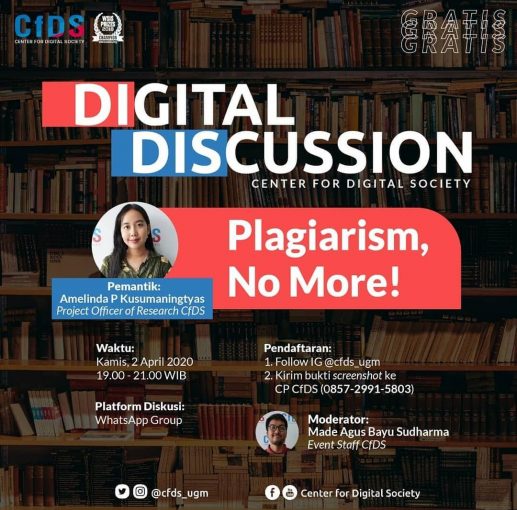
Yogyakarta, 2 April 2020—Plagiarism seems to be a topic that is close to the students because every assignments that they do should be free from plagiarism. It becomes more relevant because the midterm exam season has begun—which means the students should do a series of assignments as the substitute of midterm exam, therefore the issue of plagiarism becomes really important to be discussed. Because of that, Center for Digital Society (CfDS) Fisipol UGM brought the topic of plagiarism in the Digital Discussion #15 with the title ‘Plagiarism, No More!’ that held through the WhatsApp platform.
This discussion was moderated by Made Agus Bayu Sudharma or Mas Bayu as the event staff CfDS. Thirty minutes before the discussion was begun, moderator already reminded the participants that the discussion would begin soon. At 07.oo p.m. moderator started the discussion with the introduction of himself and explained the rules. He also said sorry because there was a change of speaker. The former speaker, Amelinda P. Kusumaningtyas or Mbak Amel as the Project Officer CfDS could not join the discussion and was replaced by Trevilliana Eka Putri or Mbak Trevi as the Manager of Research CfDS.
As the opening of the discussion, Mas Bayu asked the participants about the definition of plagiarism. The answers from participants are responded by Mbak Trevi with an explanation about the definition of plagiarism based on Minister of Education Regulations Number 17 of 2010 that said, “Plagiarism is an act, whether it is intentionally or unintentionally, in gaining or trying to gain credits or scores for a scientific work, by quoting half or all of the others people’s scientific works that claimed as their scientific work, without stated the source appropriately and adequately.” By that definition, Mbak Trevi said that there are four factors to see how a work or a writing could be seen as an act of plagiarism or not.
After that, Mbak Trevi continued her explanation about plagiarism by explaining the forms of plagiarism, there are plagiarism word-by-word, sources plagiarism, authorship plagiarism, and self-plagiarism. An act of using our own previous works without any changes in it is a form of self-plagiarism. Mbak Trevi added that in several universities that have a tasks submission system through an application like Turnitin, self-plagiarism would be very easily detected because the server stores the datas of the previous students’ assignments. Plagiarism certainly has its own consequences. In the same Minister of Education Regulation, it mentioned the consequences of plagiarism such as warning, written warning, postponement of giving out half of the students’ rights, scores cancellation, an honorable discharge of student status, an unhonorable discharge of student status, and the cancellation of diploma if the student already graduated. These consequences would adjust to the severity of plagiarism and the level of tolerance of plagiarism in each universities, departments, and lecturers.
To avoid plagiarism, a writer should write the references and sources. This citation is not just being done properly, but also adequately by writing a proper references. Mbak Trevi explained that there are two two kinds of citation, direct citation and indirect citation. Direct citation is done by quoting, and indirect citation is done by paraphrasing. Both of them should put the references and sources in the bibliography. According to Mbak Trevi’s explanation, lecturers prefer the indirect citation with paraphrase, because this kind of citation could summarize a long writing to be just one or two sentences. Other than that, paraphrase indicates that students understand about the substance or message that the writer wants to deliver.
Meanwhile, for the references writing itself can be done by opening the references guide. There are many references guide with various styles that could be learn through a page like Mendeley, Zotero, etc. Some commonly used references writing styles are Harvard style, MLA, APA, Chicago, Turabian, etc. Mbak Trevi explained about one of the most common mistakes related to references was the questionable of the source credibility. For the example, in a scientific work or article, the reference is just from an online newspaper; put an online article that is actually a satire; or take the writing source from a news or a writer that is not neutral. Because of that, Mbak Trevi mentioned several pages that could be used to get a credible sources, it was Google Scholar, Microsoft Academic Search, Open Library, UGM Summon, and Researcher.
The discussion was closed with two sessions of question and answer with a total of four participants. Between the first and second sessions of question and answer, Mas Bayu as the moderator also asked to the speaker. Mbak Trevi answered the questions from participants sequentially. She also gave concrete examples in her answers to make her explanation more understandable for the participants. The discussion was closed at 09.00 p.m. Even though the discussion already done, Mas Bayu and Mbak Trevi welcomed the participants who still had questions to ask them through Instagram account or Twitter of CfDS.
